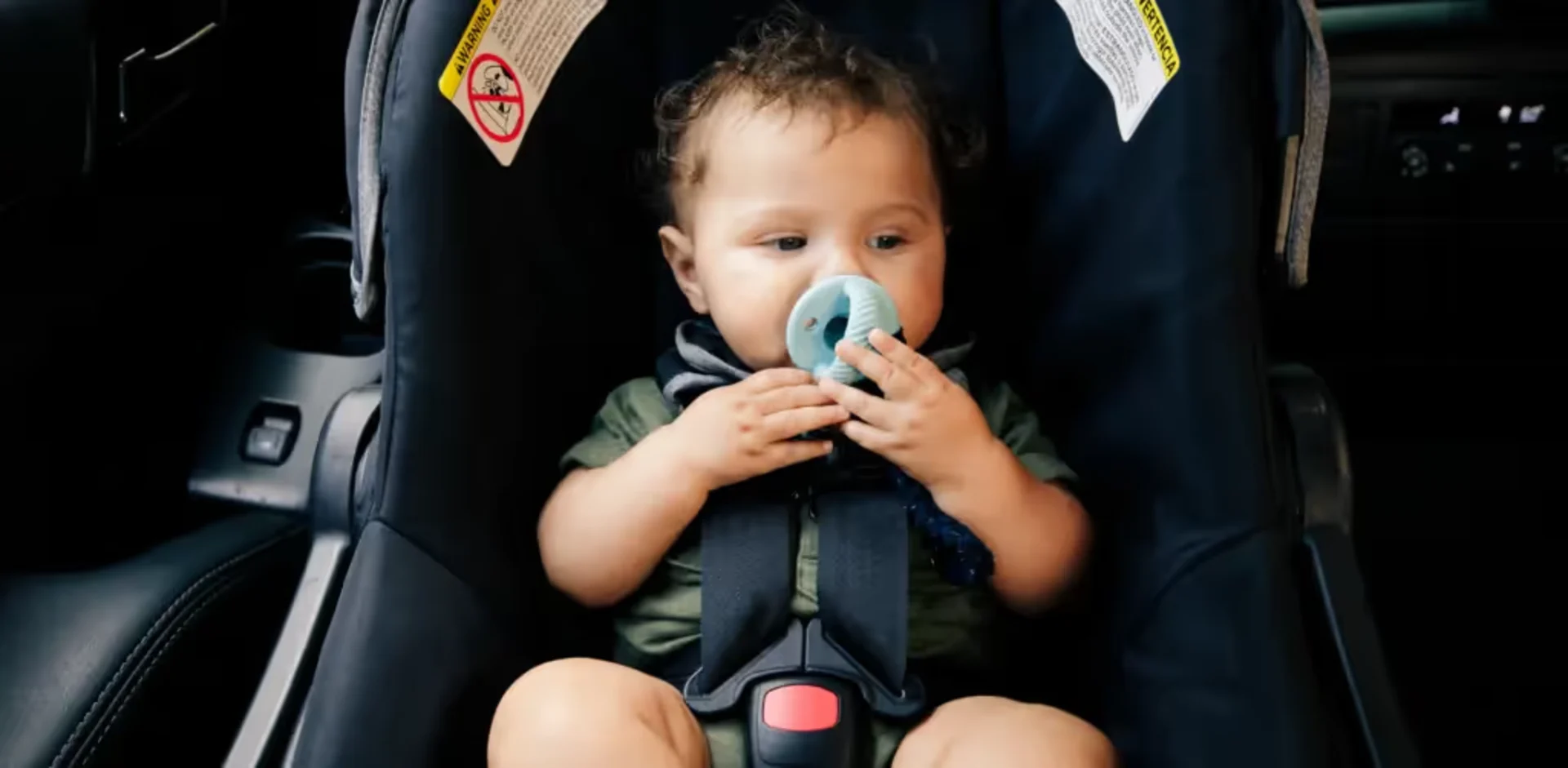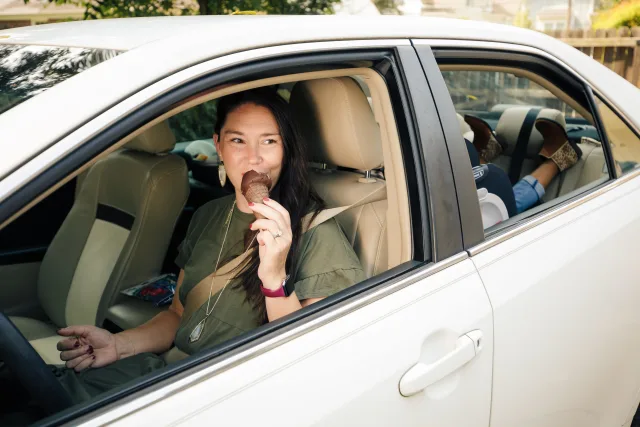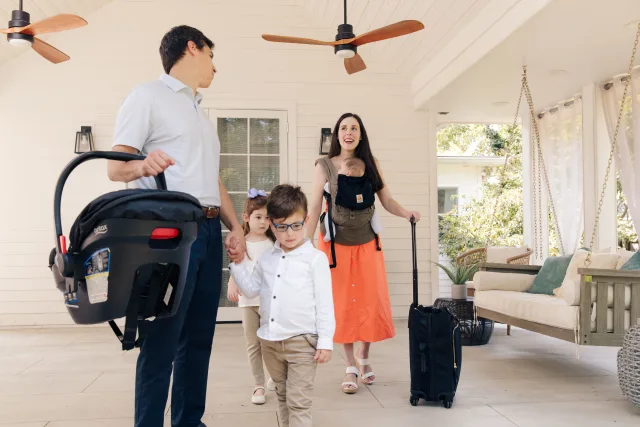When you’re traveling with a child of any age, the topic of feeding almost always comes up. Whether it’s your 3-year-old begging for a snack or your newborn screaming for a bottle, you’ll have to decide how to respond to these requests for food. Before you make the most convenient choice, consider the safety risks too!
There are quite a few dangers associated with feeding your baby while they’re in their car seat. Today, we’re going to give you the rundown on riding and snacking, so you can make the best decision on your next big road trip or weekly errand. Here’s what you need to know:
Can You Feed a Baby in a Car Seat?
Here’s the down and dirty: it’ll never be 100% risk-free to let a child eat in their car seat. We know, friend, it can be super convenient to quickly hand your kiddo a snack or give the baby a bottle while riding, but there are several risks involved. In our professional opinion, it’s absolutely not worth the risk for children under age two. And we’d use lots of caution even with older kids!
No matter where you’re going, you should plan your feeding stops. Take breaks along the ride to get wiggles out and have a snack. Plus, it’s good for infants specifically to get out of the car every two hours. We recommend getting out of the car for 15-30 minutes at a minimum. So, next trip, pack your food and bottles, but save them for pit stops.
Are Car Snacks for Toddlers Safe?
It’s not just choking hazards like grapes and cherry tomatoes that should be avoided in the car, all food items carry an extra choking risk when a child eats in their car seat. If you absolutely have no choice but to feed your toddler something, choose snacks that are soft and very low risk, like applesauce pouches.
Again, we don’t recommend feeding a child in the car. However, if the child’s tantrum turns into a dangerous distraction, you may have to weigh the risks of both situations. Even in that case, the best option is to get to a safe location where you can park to feed your child and refocus for the rest of the drive.
Can You Breastfeed or Bottle Feed a Baby in a Car Seat?
It’s not just solid foods that are dangerous, but infant drinking is dangerous as well. For example, the breast feeding process is dangerous in a moving car no matter how you do it. If you remove the child from the car seat, of course they’re not safely restrained. And if you lean over the baby’s seat to breastfeed — whether you completely unbuckle or you put the shoulder belt behind your back — your body could become a projectile in a crash, injuring your child. And that’s not to even mention the risk to your own personal safety if you aren’t properly restrained. Your life is not worth risking, no matter how hungry that sweet baby is!
There are also risks with feeding a baby in a moving vehicle. The reclined position of a car seat combined with the motion of the vehicle can increase the risk of choking or aspiration — improper swallowing allowing milk to enter the lungs. The bottle can become a projectile, and so can your arm if you’re reaching over baby’s seat to hold the bottle for an extended period of time. Here are the main risks that come with feeding in the car:
Risks of Feeding Babies in Car Seats
Projectiles
In a collision, any loose items become projectiles. Soft items aren’t a concern, but anything hard or hefty could increase the risk of injury or death. This is why parents should be careful about what toys they bring into the car and why they should carefully organize their vehicle.
Bottles, sippy cups, utensils, and other food serving items can become dangerous projectiles in a crash. So keep feeding to a minimum in the car. You never know when you might get into a collision.
Motion Sickness
Eating in a moving car can make an adult sick. Of course, it can make your child’s tummy upset too. Vomit not only makes a mess, but it can be a choking hazard—especially for a baby strapped into a reclined infant car seat. It’s not worth the risk and hassle.
Choking Hazards
Obviously, one of the main reasons to prohibit eating in the car is choking hazards. When seated eating at a table, it’s easy to identify choking and act fast. However, there is no safe way to help a choking child in a moving vehicle. Read that again. It’s a big deal! And the child’s body position when buckled into their car seat can cause increased choking risk even with foods that don’t ordinarily cause problems. So prepare to feed your child at your next stop where you can supervise them well and get to them quickly.
Mess
Making a mess might seem like no big deal, because if you have kids, you’re used to that stuff! However, car seats have sophisticated construction, and cleaning them the wrong way can weaken the straps and materials, making them less safe in an accident.
If you don’t allow eating in the car seat, odds are you won’t need to clean the car seat covers as frequently. When you do need to clean the car seat because of a potty accident or other spill, make sure to follow our safe car seat cleaning guide.
Feeding children in car seats is not totally safe no matter the circumstances or food choice.
We know that traveling with toddlers and infants isn’t easy. We know the temptation to give them a bottle or a package of fruit snacks is inevitable. But, try to hold firm on your informed choices, knowing it’s the best way to keep your baby safe! Plan plenty of stops along the way (rest stops and playgrounds are both good options) and leave extra time for all trips to make sure you get those kiddos fed safely.
For more car seat safety education, look into our popular car seat courses and read our blog. And, if you can’t find an answer to your question, follow us on Instagram and ask away. We look forward to you joining our community.
As an Amazon Associate, Safe in the Seat earns from qualifying purchases.






